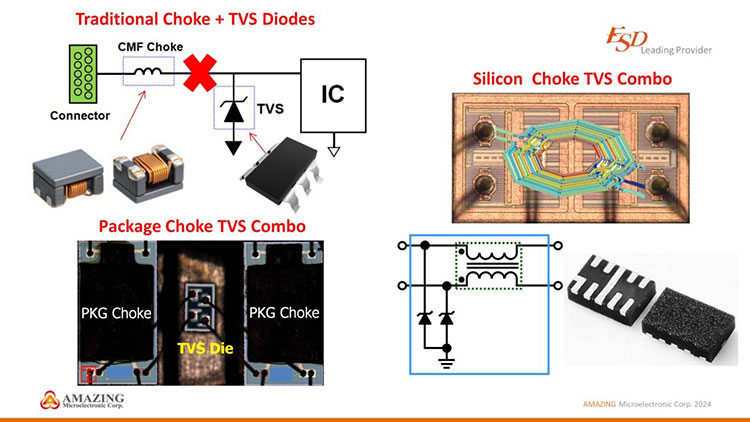A Comparison of Traditional, Multi-Chip, and Single-Chip EMI Choke TVS Combo Technologies
In modern electronic product design, addressing EMI (Electromagnetic Interference) and ESD (Electrostatic Discharge) protection is crucial. To tackle these challenges, engineers often rely on EMI common mode filters (CMF) and TVS (Transient Voltage Suppression) to safeguard sensitive circuits. However, as technology advances, the integration of EMI choke and TVS technologies continues to evolve. This blog compares three different EMI choke TVS Combo technologies—traditional, multi-chip, and the latest single-chip solutions—highlighting their advantages and disadvantages in practical applications.
Limitations of Traditional EMI Choke and TVS Integration
The traditional approach to integrating EMI choke and TVS typically involves placing these two components separately on the PCB. While this method can achieve EMI filtering and ESD protection to some extent, its limitations are evident. First, this approach increases the complexity of PCB layout and takes up more space, which is particularly challenging in high-density electronic devices where space is limited. Additionally, the arrangement of traditional choke and TVS components may lead to a reduction in signal integrity and protection capabilities, ultimately affecting the stability and performance of the system.
Multi-Chip Package EMI Choke TVS Combo Technology
To address the shortcomings of traditional integration methods, multi-chip package technology emerged. This technology integrates the EMI choke and TVS within a single package, reducing the complexity of PCB layout and space usage. By minimizing the distance between components, multi-chip package technology can effectively ensure signal integrity and system reliability. However, despite its success in many applications, multi-chip package technology still faces challenges such as higher costs and complex manufacturing processes.
Advantages of Single-Chip EMI Choke TVS Combo Technology
Currently, Amazing Microelectronic Corp. is developing a more advanced single-chip technology that integrates the choke and TVS diode on the same silicon die (Figure 1).
 Figure 1: Traditional multi-chip choke and TVS diode vs. single-chip choke TVS diode combination. (Image source: Amazing Microelectronics)
Figure 1: Traditional multi-chip choke and TVS diode vs. single-chip choke TVS diode combination. (Image source: Amazing Microelectronics)
The main advantages of this technology include:
- Smaller Size: The single-chip technology takes component integration a step further, making it more suitable for ultra-compact and high-density electronic designs.
- Higher Efficiency: The tight integration within the single chip further reduces parasitic parameters, making EMI filtering and ESD protection more effective.
- Lower Cost: Since the entire component is fabricated on a single silicon die, the manufacturing process becomes simpler and more efficient, leading to lower production costs and broader application potential.
A practical example of this advanced integration can be found in Amazing Microelectronic’s EMI Filter Solution, which provide effective protection for high-speed interfaces in compact electronic systems.
Conclusion
The integration of EMI common mode filters with TVS is rapidly evolving from multi-chip packages to single-chip solutions. These technologies not only address the limitations of traditional choke components but also provide new solutions for miniaturization and high performance in electronic devices. For every engineer focused on electronic design, understanding and applying these new technologies will be key to enhancing product competitiveness.

Have questions or comments? Continue the conversation on TechForum, DigiKey's online community and technical resource.
Visit TechForum






